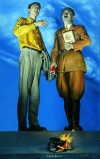
Illustration:
ill. 5.79 b (set: 5.76)
Author:
Derek McNamara
Date:
07. 12. 2007
Genre:
photograph
Material:
Internet file, colour, original source: photograph, colour
Source:
Cultural Revolution Style Restaurants, DACHS 2009 Cultural Revolution Style Restaurants, Heidelberg catalogue entry
Keywords:
Mao Zedong, Mao portrait, leaders, everyday life, contemporary China, popular culture, tourism
Cultural Revolution Style Restaurants
Quite evidently, the religious fervor for Mao Zedong once prescribed during the Cultural Revolution remains an important element in the popularity of the Great Helmsman, Great Leader, and Great Chairman, the “red, red sun in our hearts” even today: A China Youth Daily (中国青年报) poll of 1995 found that of 100,000 respondents, 60 percent of which had been born after 1970, 94.2 percent named Mao as the most admired Chinese personality (with Sun Yatsen second). It is for this reason that millions would form the audience for the Red Sun songs, that many of them would take part and watch Red Sun quizzes and that they would be quite willing to eat their daily lunches in restaurants and celebrate their weddings in decorations with MaoArt, too (ill. 5.79a&b).
In 1992, Jia Lusheng and Su Ya published a book entitled The Sun That Never Sets (不落的太阳 Buluo de taiyang). In it, they suggest that China’s continued fascination with Mao reflects a longing for those early years when the country seemed more stable and had a “leader of mythic proportions” to revere. In view of the “Red Sun Fever” in music and the trendy commercial chic feel the revolution would acquire a few years later (with the Lei Feng sneaker by Li Ning and Linux 2000, and, more recently, Cultural Revolution-style restaurants or weddings, see ill. 5.79), it was prophetic of them to argue in 1992, that the symbols of the Chinese Communist Revolution—indeed, its whole legacy—was able to evoke primal feelings for many Chinese of pride, respect, and awe. Looking back to a golden age of the mythical Yellow Emperor and other model rulers such as Yao and Shun had been common practice in traditional China. Communist China, however, had long since preached an evolutionary model of history. Yet it has now developed the fantasy of another golden age in the past: Maoist rule (including the periods of political campaigns and purges that reached their apogee in the late 1950s and 1960s). This explains why Mao is “easily the best-selling author in Chinese history” (Leese 2006, 122) and has continued to thrive as such (with the financial crisis, this has even increased). Mao’s success is based on, but it also exists in spite of, the ritual repetition it underwent especially, if not exclusively, during the Cultural Revolution. Ritual repetition and medial multiplication made his face as well as his words into (not always disliked) propagemes.












































































































